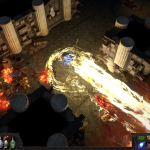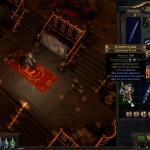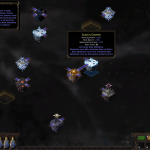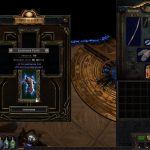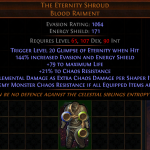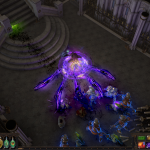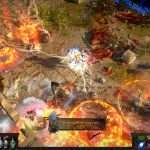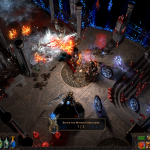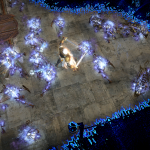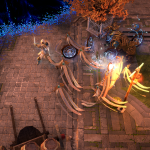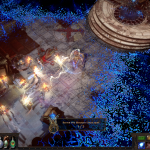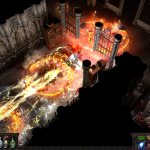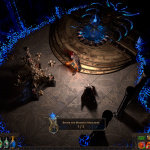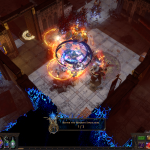
Betrayal. Incursion. Prophecy. Breach. Talisman. Nemesis. Ambush. Instead of words of the day, Path of Exile has words of the league. And with so many more words in the English Language, I can’t see Grinding Gear Games slowing down any time soon! This quarter’s word is Synthesis. Now the question is, what does it mean and when does it arrive?
To find out, I sat down and chatted with Producer Chris Wilson about the details of this new league – and I also got a few details of what lay beyond! Synthesis in a synopsis: Helping the new NPC Cavas regain his memories by building a game board of new world areas to explore and plunder. For a more intricate answer, keep reading. This new challenge league launches on PC on march 8th, with XBox One following on March 11th. The PlayStation 4’s launch will be in mid-March (apparently, it’s genuinely difficulty to get things certified over Christmas!).
 A glimpse at 2019
A glimpse at 2019
Before delving into the upcoming content of the league (because obviously you didn’t come to read about that), let’s actually take a look at the upcoming content of the year. You’ve already got a general idea of the flow of releases thanks to Grinding Gear Games’ regular cadence, but this time Wilson not only confirmed it all ahead of time but added in some extra info: March leads the year off with the Synthesis expansion, and then 3.7.0 will launch in June and 3.8.0 will launch in September.
In November, fans will have the chance to participate in the ExileCon fan convention in New Zealand, where Wilson emphasized that not only will the 2.9.0 expansion be announced (for launch it December) but it’ll be available to play early. Additionally, players will learn about the following expansion earlier than ever before: Fans will be treated to details on the 4.0.0 mega expansion coming 2020. As if we needed another reason to want to attend the con! More details will come soon.
Synthesis: Map formation
Who is Cavas? That, we do not know — yet. Because he doesn’t even know. Cavas, which is Latin for hollow, has lost all of his memories, and he is enlisting players’ help to find them. That’s the whole story behind the league, and players will help uncover it as they play. Each adventure map in the game will have a memory fragment encounter, and Cavas will come along and open it.
But it can’t be just that simple. Wilson explained that there is a “fair amount of time pressure in these”; players dive in for a mad dash through a Breach-esque rapidly decaying memory. In order to secure that memory for Cavas, players have to stabilize it by tagging the two to four memory stabilized scattered throughout. A stabilized memory is saved.
 Now comes the part about piecing the memories together. This is done by adding the fragments you procured to the ones already in the Memory Nexus. There’s more to it than just plopping them down willy-nilly, though. Think of the Memory Nexus as a board game-meets-puzzle. You need to place fragments in such a way as to create a solid path to travel (think Candyland) between the ones already present, some of which have rewards. The puzzle part comes in because the connection points must also match. Connections points for each fragment are equal to the number of stabilizers it had, and once placesd a fragment cannot be moved. There will be a limit to how many can be placed, but Wilson said it isn’t finalized yet; it could be 15 or 25. Players will not likely be able to connect to all fragments already on the board (and yes, like the Incursion temple, what fragments and their positions are different for each person), so picking which ones are most desired to reach is key. And then it gets really interesting!
Now comes the part about piecing the memories together. This is done by adding the fragments you procured to the ones already in the Memory Nexus. There’s more to it than just plopping them down willy-nilly, though. Think of the Memory Nexus as a board game-meets-puzzle. You need to place fragments in such a way as to create a solid path to travel (think Candyland) between the ones already present, some of which have rewards. The puzzle part comes in because the connection points must also match. Connections points for each fragment are equal to the number of stabilizers it had, and once placesd a fragment cannot be moved. There will be a limit to how many can be placed, but Wilson said it isn’t finalized yet; it could be 15 or 25. Players will not likely be able to connect to all fragments already on the board (and yes, like the Incursion temple, what fragments and their positions are different for each person), so picking which ones are most desired to reach is key. And then it gets really interesting!
As if finding and fitting the right fragments together to get to where you want to go wasn’t enough, each fragment actually has a maximum-use counter. After so many runs, a fragment will decay completely; on that final run, it will mirror its game-world properties and collapse around you. The reward and boss memories, however, always have just a single use, so once inside, players had better hustle to complete it before it poofs. Oh, and each fragment has special mods that chance the map — each one you add increases the entire board’s global mods! String enough together and you could be facing monsters with majorly increased stats and density. Additionally, there is a yellow space called the Memory Amplifier where players can plug in a fragment and get those mods amplified, like doubling the mods. Now you can really see how players can customize their challenge in Synthesis.
 Synthesis: Item formation
Synthesis: Item formation
While Synthesis more than earns its name with the map creation, it also refers to the the league’s new way of forming items. Players will find a plethora of fractured items throughout the memory fragments. Being as they come from decaying memories, these items are broken. That doesn’t make them worthless, however; broken just means that some of the properties of the item are stuck in place and cannot be changed or removed. Perhaps players will find an item with desired mods stuck in place, which will make it easier to reroll mods to make it even better. For all the items where undesired mods are stuck, you can turn them into fodder for synthesized items.
Before Synthesis, players had to either accept the implicit mod an item came with or gamble with the Vaal corruption mechanic, which could either improve or ruin it. “Our goal with this new system that we’re coming up with is that we want a way for people to be able to change the implicit mods of items but we want it so they have some degree of control over what they get while also having randomness,” Wilson explained to me. “And we want it so that this is done before the item is actually fully crafted.” Synthesis allows this, whereas the corruption system broke an already completed item.
 In the Memory Nexus, players can toss three fractured items of same class (e.g., three rings, three boots, etc.) into the Synthesizer. What is formed is a new, white (normal) item that has not been crafted in game before. And yes, these items can be upgraded and enhanced just like all other regular items. Which fractured items you put into the machine then influence what you get out, Wilson explained; implicit mods of the new item are based on the explicit mods that are consumed in the creation process. Wilson emphasized that while GGG would not be explaining the complicated formula for how the Synthesizer works, the devs do expect players to piece it together over time and anticipate advanced players will start using the machine in ways that will really pay off for them. “This gives the type of endgame finessing that Path of Exile is known for,” Wilson said.
In the Memory Nexus, players can toss three fractured items of same class (e.g., three rings, three boots, etc.) into the Synthesizer. What is formed is a new, white (normal) item that has not been crafted in game before. And yes, these items can be upgraded and enhanced just like all other regular items. Which fractured items you put into the machine then influence what you get out, Wilson explained; implicit mods of the new item are based on the explicit mods that are consumed in the creation process. Wilson emphasized that while GGG would not be explaining the complicated formula for how the Synthesizer works, the devs do expect players to piece it together over time and anticipate advanced players will start using the machine in ways that will really pay off for them. “This gives the type of endgame finessing that Path of Exile is known for,” Wilson said.
As a side note, Wilson told me that with synthesizing and fractured items, there are going to be some interesting effects on the game economy. That makes sense: It isn’t often people pay well to gobble up bad gear!
Souped up spellcasting and other stuff
The league is never all that happens during the big updates. Following an alliteration theme, Synthesis focuses on fixes in spellcasting. The dilemma that Wilson said really needed work was that even though there are around 40 existing spells in Path of Exile, players use only the top five most powerful ones. Not only that, but players have avoided manually casting spells altogether by utilizing totems, traps, and mines, and creating complex cast-on-damage-taken setups that let them stand safely out of the way. Wilson emphasized these are great, but manual casts need to be just as viable, so spells got a system-wide rebalance to get them more equal in power. No easy task, we are sure! Wilson said:
“We firmly believe, and have the data to back up, that if we can add more diversity to the system and provide more choices that it will be much better for the game overall. It provides a longer playtime, it provides players playing more characters — basically it’s aspirationally good for everyone in Path of Exile.”
Then he added that while the team loves the Synthesis content (which will be great for the game), he “is personally most excited about the fact that [GGG is] fixing the spellcasting dilemma by rebalancing all 40+ of the different spells so that they’re on equal ground with each other and providing incentives for people to actually cast the spells themselves the dangerous way.”
In line with this, Synthesis introduces two new archetypes, the chaos spellcaster and the holy spellcaster. Six brand-new primary spells are split between these two archetypes, and two new support gems will also change how you play a spellcaster.
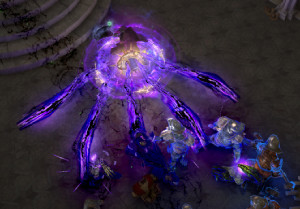 As is customary, Wilson shared two of these new skills: The chaos spellcaster will use Soulrend, which shoots out a slow-moving purple glowy projectile that causes a chaos DoT to everything near it. It can utilize all the same support gems skills that projectiles do, but players might also want to consider also slowing this one down even more to cause additional damage. Divine Ire is for the holy spellcasters, and it is a channeling spell that charges up from the life force of enemies around it. A good use of this is to kill minions and then let loose the massive blast on a boss! You can also charge it on the boss and then blast it, but the speed of charging is proportional to the number of mobs.
As is customary, Wilson shared two of these new skills: The chaos spellcaster will use Soulrend, which shoots out a slow-moving purple glowy projectile that causes a chaos DoT to everything near it. It can utilize all the same support gems skills that projectiles do, but players might also want to consider also slowing this one down even more to cause additional damage. Divine Ire is for the holy spellcasters, and it is a channeling spell that charges up from the life force of enemies around it. A good use of this is to kill minions and then let loose the massive blast on a boss! You can also charge it on the boss and then blast it, but the speed of charging is proportional to the number of mobs.
Of course, Synthesis also comes with new uniques — 16 of them, to be exact. More information on those will come as we get closer to launch, but new chaos spellcasters might be interested to know that one makes a bubble that slows the action speed of enemies caught within it by 40%.
And last but not least, Betrayal and Jun will be moving to the core game alongside Einhar and the rest of the new masters. However, instead of discovering a Betrayal event every zone, they will be lessened to three events every eight zones. Now this means that you will be hitting multiple events in the same zone, but Wilson assured me that effort has been made to make sure that the events don’t overlap in the same zone. After waiting all that time, players might find it pretty frustrating to lose the opportunity for an event because you are dealing with another!
Excited to know more? Massively OP will be debuting a brand-new regular Path of Exile column next month – so stay tuned!


